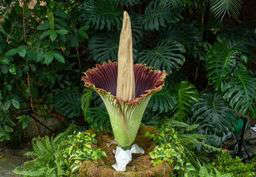
The rare corpse flower is expected to bloom at the Meijer Gardens this weekend.
GRAND RAPIDS, Mich. — June 11, 2024 —(Press Release) - Frederik Meijer Gardens & Sculpture Park and Grand Valley State University are excited to announce the bloom of a rare Amorphophallus titanum, commonly known as a corpse flower. Lovingly named The Beast by the GVSU biology department staff, peak bloom is expected between June 14 and 16, 2024 inside the Grace Jarecki Seasonal Display Greenhouse at Frederik Meijer Gardens & Sculpture Park. The Beast is on loan from GVSU and is a part of their permanent collection. Guests can experience the unique smells and sights of this rare event during Meijer Gardens’ normal hours of operation. Tickets can be purchased in advance at MeijerGardens.org/tickets
The corpse flower (Amorphophallus titanum) – also called titan arum – is one of the largest and rarest flowering plants in the world. Its unpredictable blooming cycle makes each event a notable occurrence. It can take up to a decade to produce a flowering structure, and when it blooms is open for only 24 to 36 hours.
The bloom emits a strong odor resembling that of rotting flesh or a decaying animal, which is how it got the name "corpse flower." Its distinctive odor attracts pollinators, including carrion beetles and flesh flies, that feed on dead animals and is at its most pungent during peak bloom. The corpse flower can grow up to 10 feet tall and 4 feet wide. Its leaf structure can reach up to 20 feet in height and 16 feet across. Although the enormous plant in bloom resembles one giant flower, it actually comprises a fleshy central spike called a spadix that holds two rings of male and female flowers, wrapped by the frilly spathe, a modified leaf that resembles a petal.
While the corpse flower's bloom is short-lived, the plant itself can live for 40 years or more. It spends much of its life cycle as a dormant underground tuber. The corpse flower is native to the rainforests of Sumatra, Indonesia and was first reported in 1878.
“This is an incredibly exciting and unique thing to experience," said Steve LaWarre, Senior Vice President of Horticulture at Frederik Meijer Gardens & Sculpture Park. "Many people go through their entire careers never seeing an example like this in person. We are thrilled that in addition to our own Putricia, which bloomed in 2018, we are able to display another Amorphophallus titanum thanks to our colleagues at Grand Valley State University, and that the public is showing such great interest. We are especially excited to work with the biology department at GVSU and are thankful for the collaboration between our organizations.”
GVSU's plant, which was donated in 2015 by Tim Strickler, professor emeritus of biomedical sciences, bloomed for the first time just two years ago.
"Barbara Kindschi Greenhouse staff members at Grand Valley were definitely surprised to see our Amorphaphallus tintanum starting to bloom again so soon after the last bloom in the spring of 2022," said Christina Hipshier, greenhouse supervisor. "We are grateful for the help from Frederik Meijer Gardens & Sculpture Park in displaying The Beast. Considering that this bloom is happening during a time when most students are not on campus, we are excited for the visibility that this collaboration will bring."

 4/18/25 - List of Easter Events for the Kids
4/18/25 - List of Easter Events for the Kids
 04/15/25 - Red Cross Going Door to Door This Month
04/15/25 - Red Cross Going Door to Door This Month
 11/06/24 - ELECTION 2024 - ELECTION RESULTS
11/06/24 - ELECTION 2024 - ELECTION RESULTS
 8/15/24 - Groundbreaking For New Children's Rehab Hospital
8/15/24 - Groundbreaking For New Children's Rehab Hospital


